Giovanna Castellano
ArtSeek: Deep artwork understanding via multimodal in-context reasoning and late interaction retrieval
Jul 29, 2025Abstract:Analyzing digitized artworks presents unique challenges, requiring not only visual interpretation but also a deep understanding of rich artistic, contextual, and historical knowledge. We introduce ArtSeek, a multimodal framework for art analysis that combines multimodal large language models with retrieval-augmented generation. Unlike prior work, our pipeline relies only on image input, enabling applicability to artworks without links to Wikidata or Wikipedia-common in most digitized collections. ArtSeek integrates three key components: an intelligent multimodal retrieval module based on late interaction retrieval, a contrastive multitask classification network for predicting artist, genre, style, media, and tags, and an agentic reasoning strategy enabled through in-context examples for complex visual question answering and artwork explanation via Qwen2.5-VL. Central to this approach is WikiFragments, a Wikipedia-scale dataset of image-text fragments curated to support knowledge-grounded multimodal reasoning. Our framework achieves state-of-the-art results on multiple benchmarks, including a +8.4% F1 improvement in style classification over GraphCLIP and a +7.1 BLEU@1 gain in captioning on ArtPedia. Qualitative analyses show that ArtSeek can interpret visual motifs, infer historical context, and retrieve relevant knowledge, even for obscure works. Though focused on visual arts, our approach generalizes to other domains requiring external knowledge, supporting scalable multimodal AI research. Both the dataset and the source code will be made publicly available at https://github.com/cilabuniba/artseek.
I Dream My Painting: Connecting MLLMs and Diffusion Models via Prompt Generation for Text-Guided Multi-Mask Inpainting
Nov 28, 2024
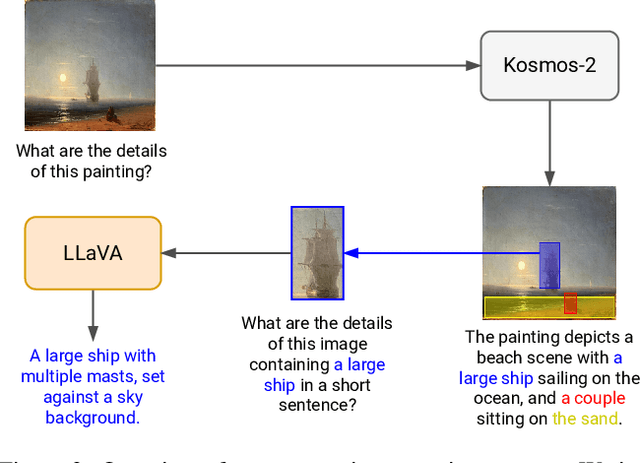


Abstract:Inpainting focuses on filling missing or corrupted regions of an image to blend seamlessly with its surrounding content and style. While conditional diffusion models have proven effective for text-guided inpainting, we introduce the novel task of multi-mask inpainting, where multiple regions are simultaneously inpainted using distinct prompts. Furthermore, we design a fine-tuning procedure for multimodal LLMs, such as LLaVA, to generate multi-mask prompts automatically using corrupted images as inputs. These models can generate helpful and detailed prompt suggestions for filling the masked regions. The generated prompts are then fed to Stable Diffusion, which is fine-tuned for the multi-mask inpainting problem using rectified cross-attention, enforcing prompts onto their designated regions for filling. Experiments on digitized paintings from WikiArt and the Densely Captioned Images dataset demonstrate that our pipeline delivers creative and accurate inpainting results. Our code, data, and trained models are available at https://cilabuniba.github.io/i-dream-my-painting.
Neural network modelling of kinematic and dynamic features for signature verification
Nov 26, 2024Abstract:Online signature parameters, which are based on human characteristics, broaden the applicability of an automatic signature verifier. Although kinematic and dynamic features have previously been suggested, accurately measuring features such as arm and forearm torques remains challenging. We present two approaches for estimating angular velocities, angular positions, and force torques. The first approach involves using a physical UR5e robotic arm to reproduce a signature while capturing those parameters over time. The second method, a cost effective approach, uses a neural network to estimate the same parameters. Our findings demonstrate that a simple neural network model can extract effective parameters for signature verification. Training the neural network with the MCYT300 dataset and cross validating with other databases, namely, BiosecurID, Visual, Blind, OnOffSigDevanagari 75 and OnOffSigBengali 75 confirm the models generalization capability.
Art2Mus: Bridging Visual Arts and Music through Cross-Modal Generation
Oct 07, 2024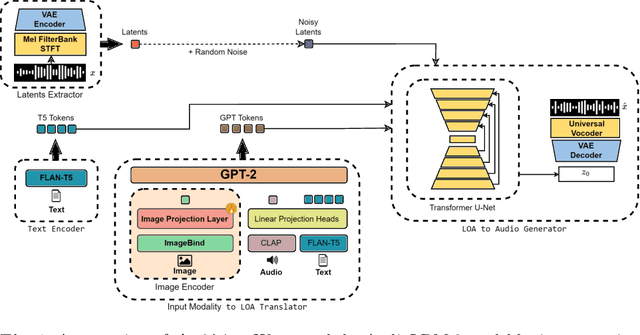

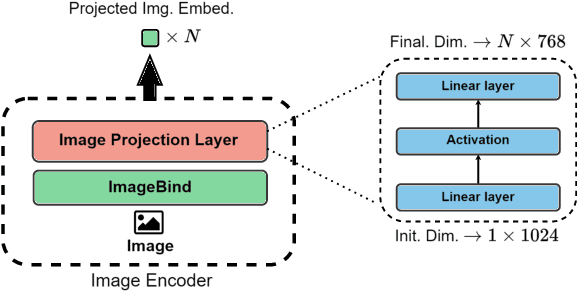

Abstract:Artificial Intelligence and generative models have revolutionized music creation, with many models leveraging textual or visual prompts for guidance. However, existing image-to-music models are limited to simple images, lacking the capability to generate music from complex digitized artworks. To address this gap, we introduce $\mathcal{A}\textit{rt2}\mathcal{M}\textit{us}$, a novel model designed to create music from digitized artworks or text inputs. $\mathcal{A}\textit{rt2}\mathcal{M}\textit{us}$ extends the AudioLDM~2 architecture, a text-to-audio model, and employs our newly curated datasets, created via ImageBind, which pair digitized artworks with music. Experimental results demonstrate that $\mathcal{A}\textit{rt2}\mathcal{M}\textit{us}$ can generate music that resonates with the input stimuli. These findings suggest promising applications in multimedia art, interactive installations, and AI-driven creative tools.
RoWeeder: Unsupervised Weed Mapping through Crop-Row Detection
Oct 07, 2024



Abstract:Precision agriculture relies heavily on effective weed management to ensure robust crop yields. This study presents RoWeeder, an innovative framework for unsupervised weed mapping that combines crop-row detection with a noise-resilient deep learning model. By leveraging crop-row information to create a pseudo-ground truth, our method trains a lightweight deep learning model capable of distinguishing between crops and weeds, even in the presence of noisy data. Evaluated on the WeedMap dataset, RoWeeder achieves an F1 score of 75.3, outperforming several baselines. Comprehensive ablation studies further validated the model's performance. By integrating RoWeeder with drone technology, farmers can conduct real-time aerial surveys, enabling precise weed management across large fields. The code is available at: \url{https://github.com/pasqualedem/RoWeeder}.
Label Anything: Multi-Class Few-Shot Semantic Segmentation with Visual Prompts
Jul 02, 2024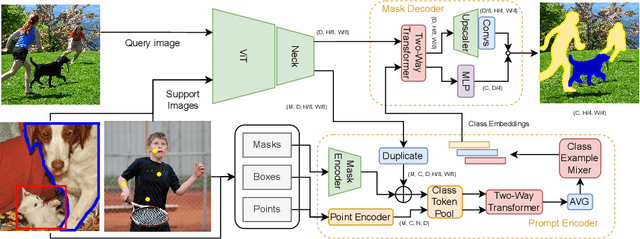

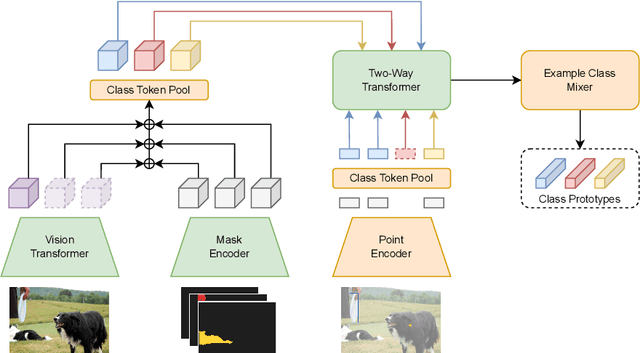

Abstract:We present Label Anything, an innovative neural network architecture designed for few-shot semantic segmentation (FSS) that demonstrates remarkable generalizability across multiple classes with minimal examples required per class. Diverging from traditional FSS methods that predominantly rely on masks for annotating support images, Label Anything introduces varied visual prompts -- points, bounding boxes, and masks -- thereby enhancing the framework's versatility and adaptability. Unique to our approach, Label Anything is engineered for end-to-end training across multi-class FSS scenarios, efficiently learning from diverse support set configurations without retraining. This approach enables a "universal" application to various FSS challenges, ranging from $1$-way $1$-shot to complex $N$-way $K$-shot configurations while remaining agnostic to the specific number of class examples. This innovative training strategy reduces computational requirements and substantially improves the model's adaptability and generalization across diverse segmentation tasks. Our comprehensive experimental validation, particularly achieving state-of-the-art results on the COCO-$20^i$ benchmark, underscores Label Anything's robust generalization and flexibility. The source code is publicly available at: https://github.com/pasqualedem/LabelAnything.
Density-based clustering with fully-convolutional networks for crowd flow detection from drones
Jan 12, 2023
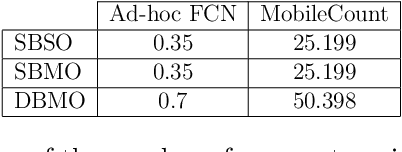

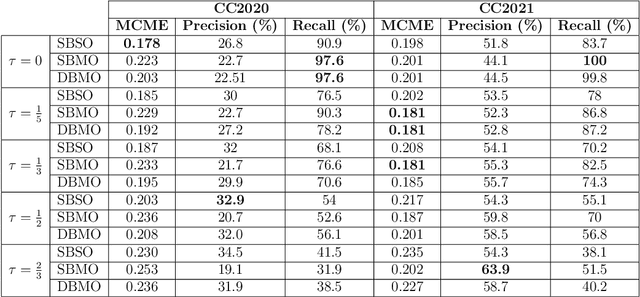
Abstract:Crowd analysis from drones has attracted increasing attention in recent times due to the ease of use and affordable cost of these devices. However, how this technology can provide a solution to crowd flow detection is still an unexplored research question. To this end, we propose a crowd flow detection method for video sequences shot by a drone. The method is based on a fully-convolutional network that learns to perform crowd clustering in order to detect the centroids of crowd-dense areas and track their movement in consecutive frames. The proposed method proved effective and efficient when tested on the Crowd Counting datasets of the VisDrone challenge, characterized by video sequences rather than still images. The encouraging results show that the proposed method could open up new ways of analyzing high-level crowd behavior from drones.
* Accepted manuscript
VisDrone-CC2020: The Vision Meets Drone Crowd Counting Challenge Results
Jul 19, 2021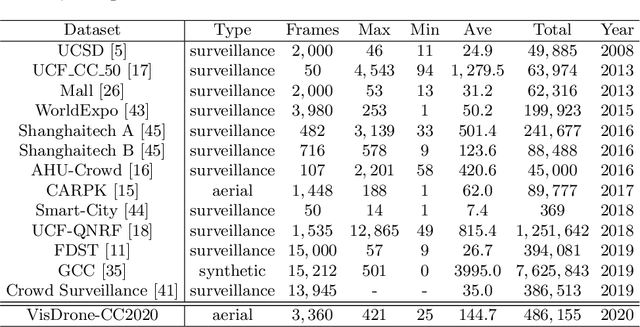
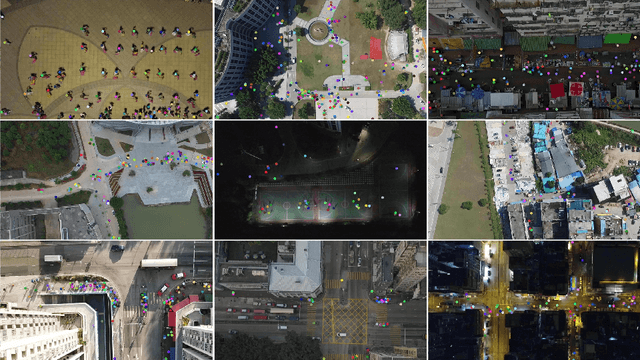
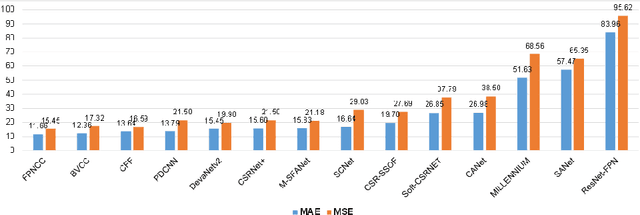

Abstract:Crowd counting on the drone platform is an interesting topic in computer vision, which brings new challenges such as small object inference, background clutter and wide viewpoint. However, there are few algorithms focusing on crowd counting on the drone-captured data due to the lack of comprehensive datasets. To this end, we collect a large-scale dataset and organize the Vision Meets Drone Crowd Counting Challenge (VisDrone-CC2020) in conjunction with the 16th European Conference on Computer Vision (ECCV 2020) to promote the developments in the related fields. The collected dataset is formed by $3,360$ images, including $2,460$ images for training, and $900$ images for testing. Specifically, we manually annotate persons with points in each video frame. There are $14$ algorithms from $15$ institutes submitted to the VisDrone-CC2020 Challenge. We provide a detailed analysis of the evaluation results and conclude the challenge. More information can be found at the website: \url{http://www.aiskyeye.com/}.
* The method description of A7 Mutil-Scale Aware based SFANet (M-SFANet) is updated and missing references are added
A deep learning approach to clustering visual arts
Jun 11, 2021



Abstract:Clustering artworks is difficult for several reasons. On the one hand, recognizing meaningful patterns based on domain knowledge and visual perception is extremely hard. On the other hand, applying traditional clustering and feature reduction techniques to the highly dimensional pixel space can be ineffective. To address these issues, in this paper we propose DELIUS: a DEep learning approach to cLustering vIsUal artS. The method uses a pre-trained convolutional network to extract features and then feeds these features into a deep embedded clustering model, where the task of mapping the raw input data to a latent space is jointly optimized with the task of finding a set of cluster centroids in this latent space. Quantitative and qualitative experimental results show the effectiveness of the proposed method. DELIUS can be useful for several tasks related to art analysis, in particular visual link retrieval and historical knowledge discovery in painting datasets.
ArtGraph: Towards an Artistic Knowledge Graph
May 31, 2021



Abstract:This paper presents our ongoing work towards ArtGraph: an artistic knowledge graph based on WikiArt and DBpedia. Automatic art analysis has seen an ever-increasing interest from the pattern recognition and computer vision community. However, most of the current work is mainly based solely on digitized artwork images, sometimes supplemented with some metadata and textual comments. A knowledge graph that integrates a rich body of information about artworks, artists, painting schools, etc., in a unified structured framework can provide a valuable resource for more powerful information retrieval and knowledge discovery tools in the artistic domain.
 Add to Chrome
Add to Chrome Add to Firefox
Add to Firefox Add to Edge
Add to Edge